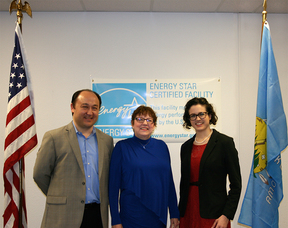|
Among the many success
stories being generated by the 20x2020 Program, the Oklahoma Department of
Human Services stands out as a sterling example of how good habits can cumulatively
have a significant budget impact. Motivated to reduce operating expenses
in order to continue providing critical social services to Oklahomans, DHS has
maintained a commitment to their energy efficiency goals since the launch of
the 20x2020 Program.
DHS united a team of relevant stakeholders from
their property and facilities management units, their leadership team, county
directors and building administrators, allowing everyone to get accurate
information and make immediate decisions. Following along as they attended
every training offered by ES2, the DHS energy management team implemented a
systematic approach to developing their behavioral energy management program.
Cathy Downey, budget analyst III in Facilities Management, took responsibility
for the agency’s utility bill data entry, while Debbie Holt, administrator of
DHS Property Management, and her team of project managers took on the
additional role of energy managers. Their team engaged DHS staff in a plug load
inventory, established Energy Conservation Guidelines with input from the
executive team, and visited each field office periodically to give informative
presentations and conduct a walkthrough while they worked on other projects. To
keep their reminders light-hearted, DHS designed mascots Les Energy and his
horse Volt.
 DHS recently received
recognition for their successful energy management when the LeFlore County DHS
office received ENERGY STAR certification, which signifies that it performs in
the top 25 percent of similar facilities nationwide for energy efficiency. When
DHS decided to select a county office to engage as a demonstration site for
their energy conservation program, Sevilla Vance, director at DHS LeFlore, was
eager for LeFlore County to lead the way.
“With the current state budget crisis, DHS is
doing everything we can to conserve money for direct client services. Our
success is due to individuals from every division working together to fully
implement the agency's Energy Conservation Guidelines and make conservation a
priority in the operation of our building.” said Vance. “I am proud of our
employees who have made an effort to modify their daily habits to reduce energy
use.”
Temur Akhmedov (ES2),
Sevilla Vance (DHS) and Claire Farr (ES2) at the ceremony recognizing DHS
LeFlore County’s recent ENERGY STAR certification.
As Debbie Holt observed, “I believe that
LeFlore County is an example of what’s becoming the norm across our entire
agency. Through our 20x2020 Program, our employees are becoming so much more
aware of daily opportunities to use energy more efficiently.” Across the agency, DHS used 20 percent less
energy in fiscal year 2015 than they did in fiscal year 2012. This allowed DHS
to spend about $500,000 less on energy bills in FY 15 than in FY 12. In addition
to the 20x2020 Program, these figures reflect that DHS has opened or closed
several facilities to align the building portfolio with their current
organizational mission. In the facilities that have been in DHS’s portfolio
since fiscal year 2012, energy use was 10 percent lower in FY 15
than in FY 12. (cont. in next column)
 Temur Akhmedov (ES2), Sevilla
Vance (DHS) and Claire Farr (ES2) at the ceremony recognizing DHS LeFlore
County’s recent ENERGY STAR certification.
Back to Top
|
Overall, DHS is establishing energy efficient
behavior as standard operating procedure and continues to seek opportunities
for improvement. As Holt explained, “When county directors and building
administrators take our energy conservation mission seriously, their staff is
much more likely to work hard to make positive changes. I think that the
majority of our people are thinking about eliminating energy waste and thinking
about what each of them can do to make it better.” The agency plans to continue
to reduce energy expenses in order to preserve funding for their critical
client services for Oklahomans.
Back to Top
I wanted to report that the program as a
whole is doing well. For organizations that have information up to date through
December 2015, when comparing the first six months of FY 16 to the baseline of
FY 12 our usage per square foot is down 5.1 percent. Over the same time period
our expenses are down 11.5 percent per square foot. Expenses are down partially
due to the usage being lower. However, many organizations are seeing lower
utility costs due to much lower fuel costs on their electric and natural gas
utility bills. The low prices for oil and natural gas that are affecting our
budget crisis are at the same time helping in our utility costs. Because of
this unique situation, effective May 21, 2016, the state consultant contract SW125
– State Facilities Behavior-Based Energy Conservation Program will end. The
20x2020 Program will continue,
it is only the consultant services that are ending. The contract termination is in the best interest of the state.
The information being entered into the
EnergyCap database will continue. The 20x2020 Program will continue. My office
will remain the primary point of contact for any questions concerning the
program. The newsletter will continue and training sessions will still occur. Like
I stated, the program will continue.
As always, if you have any questions
please feel free to contact me at any time.
Craig Cherry
Director, 20x2020
20x2020@omes.ok.gov
Back to Top
A robust energy management program
provides the ability to be proactive in finding solutions to challenges
presented by your building systems. For buildings with Building Automation
Systems (BAS), a highly cost effective solution is to utilize the graphical
user interface and perform “screen checks.” Screen checks allow the user to
take all of the data on their set points, status points and other metrics and
turn it into a diagnostic tool.
Before performing a screen check, it is
important that the system is calibrated. After ensuring that the system is working properly, the user should look at
static pressures, damper positions, fan/pump speeds and set points to verify
that everything is operating properly. Any data that does not make sense should
be followed up on immediately. Below are some tips to guide the process:
- Start with central systems first, and
then spot check smaller zones.
- Frequency of screen checks depends on
the system, but a quarterly scan should be conducted at a minimum.
- Specific checks should be performed
when particular equipment is being utilized. For example, economizers should be
checked during mild weather even if not part of the quarterly routine.
- Look at trend data (if available) when
more data is needed to troubleshoot an issue identified by the screen check.
For more information
on BAS, visit Teamwork’s Energy Manager
Resources project and click on the Files and Links headers.
Back to Top
Questions?
Email 20x2020@omes.ok.gov.
Subscribe to receive updates in your email.
Back to Top
|